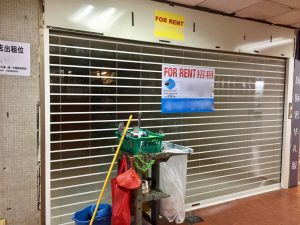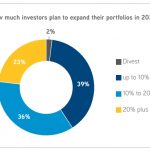Retail side property rentals was very pronounced recording the worst decline in history
 Prices of retail space decreased by 2.1% in 4th Quarter 2020, compared with the increase of 2.2% in the previous quarter. Rentals of retail space decreased by 5.2% in 4th Quarter 2020, following the decrease of 4.5% in the previous quarter. For the whole of 2020, prices of retail space decreased by 4.5%, compared with the increase of 1.3% in 2019, while rentals of retail space decreased by 14.7%, compared with the increase of 2.9% in 2019.
Prices of retail space decreased by 2.1% in 4th Quarter 2020, compared with the increase of 2.2% in the previous quarter. Rentals of retail space decreased by 5.2% in 4th Quarter 2020, following the decrease of 4.5% in the previous quarter. For the whole of 2020, prices of retail space decreased by 4.5%, compared with the increase of 1.3% in 2019, while rentals of retail space decreased by 14.7%, compared with the increase of 2.9% in 2019.
As at the end of 4th Quarter 2020, there was a total supply of 426,000 sq m GFA of retail space from projects in the pipeline, compared with the 428,000 sq m GFA of retail space in the pipeline in the previous quarter.
The amount of occupied retail space increased by 24,000 sq m (nett) in 4th Quarter 2020, compared with the decrease of 50,000 sq m (nett) in the previous quarter. The stock of retail space decreased by 26,000 sq m (nett) in 4th Quarter 2020, compared with the decrease of 53,000 sq m (nett) in the previous quarter. As a result, the island-wide vacancy rate of retail space decreased to 8.8% as at the end of 4th Quarter 2020.
Commenting on the retail side of the real estate sector, Ms Tricia Song, Head of Research for Singapore at Colliers International, said: “Rental declines were much more pronounced in the retail sector, recording the worst decline in history (data unavailable before year 2001).”
Prices for the retail side, on the contrary, showed relative resilience as owners demonstrated holding power, with institutional demand for retail assets still strong.
Commenting on the retail side rent, Ms Song noted: “In Q4 2020, rental declines of retail space in Central Region accelerated further at -5.2% QOQ versus -4.5% QOQ in Q3 2020. This is the fourth straight quarter of decline, dragged by the Central Area which fell 6.1% QOQ while Fringe Area was down 4.7% QOQ.”
For the full year, the URA’s Retail Rental Index for the Central Region collapsed 14.7% (Central Area: -13.3% YOY, Fringe Area: -15.2% YOY) in 2020 (2019: 2.9% YOY), recording the worst decline in history (data unavailable before year 2001).
“Prices
Prices of retail space in the Central Region held up better, declining only 4.5% for the full year in 2020 (2019: 1.3% YOY), given tightly-held quality retail assets and minimal transactions. This was despite a 10.5% contraction in Central Area prices, as Fringe Area prices was relatively well-supported seeing only a 3.9% contraction. In Q4 2020, Central Region retail prices was down 2.1% QOQ (Central Area: -3.4% QOQ, Fringe Area: -1.7% QOQ), as compared to a 2.2% QOQ growth in Q3 2020.
Vacancy and completions
Meanwhile, island-wide retail vacancy improved 0.8bps QOQ to 8.8% in Q4 2020, as net absorption turned positive to 258,000 sq ft (Q3 2020: -538,000 sq ft). There was a 280,000 sq ft ft supply withdrawal in the market during the quarter. That said, 2020 total net absorption still stood at -1.7m sq ft, the worst ever experienced in a single year since year 2001 (data unavailable before year 2001).
Outlook for Retail Side
With the transition into Phase 2, and together with government and several landlords’ support measures to aid retail tenants, retail sales (excl. motor vehicles) saw an improvement to -2.9% YOY in November. On the ground, while there were several high profile brand closures in the year including Robinsons, Esprit, Sportlink, Topshop and many F&B brands, shopping malls saw higher shoppers’ traffic and tenant sales during Phase 2 – it was reported by Capitaland Integrated Commercial Trust that shoppers’ traffic and tenant sales of their malls in Q4 2020 achieved 67.9% and 94.5% of Q4 2019’s level respectively.
That said, looking ahead we believe retail sales remain fragile and vacancy at retail space could remain volatile as the retail tenant mix evolves. The pandemic has accelerated the growth of e-commerce, which continues to be a long term headwind for the sector, among other challenges. Online sales as a proportion of total retail sales rose to 14.3% in November compared to 5.8% in January 2020, and the trend could continue.
As such, we expect average retail rents to stay flat in 2021 and improve gradually thereafter with some reprieve from limited new supply, which are mostly concentrated in suburban and fringe areas where there are well-defined population catchments.
Moving forward, we believe the retail scene could adapt to the demands and preferences of consumers amid changing times. Due to the pandemic, we have seen increased demand for necessities, food and beverage, furniture, technology goods and health and fitness goods, which will change the retail mix in the malls. Brick-and-mortar retailers could also provide differentiated experiences, human touch, and customer services which e-commerce will not be able to. Post Covid-19, landlords may also look at lease and rent restructurings such as adopting Gross Turnover Rent (GTO) rent.”
The URA’s real estate statistics for 4th Quarter 2020 trekked residential, office and retail data. Prices of private residential properties increased by 2.1% in 4th Quarter 2020, compared with the 0.8% increase in the previous quarter. For the whole of 2020, prices of private residential properties increased by 2.2%, compared with the 2.7% increase in 2019.
Prices of office space decreased by 3.1% in 4th Quarter 2020, compared with the 0.2% increase in the previous quarter showed the Quarter 4 data by Urban Redevelopment Authority (URA). Rentals of office space decreased by 3.5% in 4th Quarter 2020, compared with the 4.5% decrease in the previous quarter. For the whole of 2020, prices of office space decreased by 10.7%, compared with the decrease of 0.6% in 2019, while rentals of office space decreased by 8.5%, compared with the decrease of 3.1% in 2019.
Mr Paul HO, chief mortgage officer at iCompareLoan, said: “it is still difficult to see how 2021 will pan out for real estate in Singapore. Those that want to buy or invest in properties should speak to a panel of real estate professionals as they can help you with affordability assessment and a promotional home loan. The services of such experts are free. Their analysis will give best home loan seekers better ease of mind on interest rate volatility and repayments.






